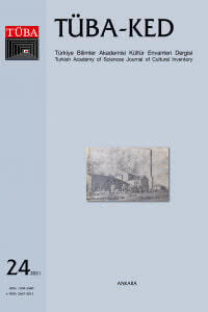‘ARKEOLOJİK ALANDA MİMARIN ROLÜ’: UYGULAMALI BİR EĞİTİM MODELİ
Tarihi çevrede çalışan mimarın, ister arkeolojik verilerin daha etkin biçimde korunması için inşa edilecek bir koruma çatısının tasarımı, ister kazılarla ortaya çıkan yapıların belgelenmesi, isterse alanda gerçekleştirilecek bir anastylosis uygulamasının planlanması olsun, hangi amaçla alanda bulunduğundan bağımsız olarak bazı temel donanımlara sahip olması beklenir. Mimarın öncelikle; tarihi yapı ve çevrenin farkına varması, onu algılaması, anlaması ve değerlendirebilmesi gerekir. Mimarlık eğitiminde bu donanımın sağlanmasına ve arkeolojik alana yönelik eğitimlerin eksik olduğu gözlemlenmektedir. Bu çalışmada, pek çok farklı disiplinin katkısını gerektiren arkeolojik alan araştırmalarında; taşınmaz kültürel mirasın tespiti, belgelenmesi ve değerlendirilmesi ile ilgili çalışmalarda sorumluluk alacak mimar ve mimar adaylarının yetiştirilmesi için önerilen uygulamalı bir eğitim modeli tartışılmaktadır. Buna yönelik bir eğitim modelinin oluşturulması ve konunun gelecekte kredili bir ders olarak da mimarlık temel eğitimi içinde yerini alabilmesi amacıyla arkeolojik kazıların sürdüğü dönemlerde mimarlık lisans öğrencileri ile seçilen alanlarda bir dizi yaz okulu gerçekleştirilmiştir. Yaz okullarında arkeolojik alanlardaki zorluklar ve kazı ekiplerinin çok disiplinli yapıları gözlemlenmiş ve yapılan eğitimlerde mimarın belgelemenin yanı sıra çok sayıda başka roller alabileceği üzerinde durulmuştur. Eğitim sırasında geleneksel ölçüm teknikleri öğretilmiş ve tatbik edilmiş, aynı zamanda dijital yöntemleri de içeren uygulamalar gerçekleştirilmiştir. Bu çalışmada, gelecekte atılması muhtemel adımlar da göz önünde bulundurularak, doğrudan arkeolojik alanda gerçekleştirilen bu yaz okullarının teorik çerçevesi ve pratik uygulamaları, yapılan gözlem ve tespitler ve katılımcıların geribildirimleri sonucunda yapılan değerlendirmeler üzerinde durulmaktadır.
THE ROLE OF ARCHITECT IN ARCHAEOLOGICAL FIELD STUDIES’: A PRACTICE-BASED TRAINING MODEL
The architect working in the historical environment is expected to have some basic knowledge, regardless of the specific purpose of their work, whether it is the design of a protection roof to be built for more effective preservation of archaeological data, the documentation of new architectural data revealed by excavations, or the planning of an anastylosis application to be carried out in the area. First of all, the architect; must be able to perceive, understand and evaluate the historical structure and environment. It is observed that the provision of this knowledge in architectural education and the training of architects for the archaeological site are lacking. In this study, in archaeological field research that requires the contribution of many different disciplines; a practical training model proposed for the education of architects and architect candidates who will take responsibility in studies related to the identification, documentation and evaluation of immovable cultural heritage is discussed. A series of summer schools were organized in selected sites with undergraduate architecture students during the active season of archaeological excavations in order to create an education model for this and to enable this topic to be able to take its place in architectural education as a credit course in the future. The difficulties in archaeological sites and the multidisciplinary nature of the excavation teams were observed in the summer schools, and it was emphasized that the architect could take on many other roles besides documentation. During the training, traditional measurement techniques were taught and applied, and introductions to digital methods were given. In this study, considering the possible steps to be taken in the future, the theoretical framework and practical applications of these summer schools held directly at the archaeological site, the observations made, and the evaluations of the feedback of the participants are handled.
___
- ADAMS, A., 2016, Drawing for Understanding, Swindon: Historic England.
- AHUNBAY, Z., 2010, “Arkeolojik Alanlarda Koruma Sorunları: Kuramsal ve Yasal Açılardan Değerlendirme”, TÜBA-KED Türkiye Bilimler Akademisi Kültür Envanteri Dergisi , (8) , 103-118 .
- ANDREWS, D., BEDFORD, J., BLAKE, B., BRYAN, P., & CROMWELL, T., 2013, Measured and Drawn, New York: English Heritage Publishing.
- BOWDEN, M., 2002, With Alidade and Tape, Swindon: English Heritage.
- EMERICK, K., 1997, “Archaeology and Architecture: A Tradition of Collaboration”, Journal of Architectural Conservation, 3(1), 52-66. doi: 10.1080/13556207.1997.10785180
- Historic England, 2018, 3DLaserScanningforHeritage:AdviceandGuidance on the Use of Laser Scanning in Archaeology and Architecture, Swindon. Historic England.
- ICOMOS Charter, 1990, The Protection and Management of the Archaeological Heritage
- ICOMOS Charter, 1993, Guidelines on Education and Training in the Conservation of Monuments, Ensembles and Sites
- ICOMOS Charter, 1996, Principles for the Recording of Monuments, Groups of Buildings and Sites
- KOLAY, İ., KUBAN, Z., 2009, “İTÜ Mimarlık Fakültesi Mimarlık Tarihi Anabilim Dalı’nın Tarihi”, TALID Türkiye Araştırmaları Literatür Dergisi 7, 673-683.
- KUBAN, N., KÂHYA, Y., 2016, “Mimari Mirasın Korunmasında Uygulama Elemanlarının Yetiştirilmesine Yönelik Yaygın Eğitim Uygulamaları”, METU Journal of the Faculty of Architecture, 33(1), 147-167.
- LETELLIER, R., SCHMID, W., LeBLANC, F., 2007, Recording, Documentation, and Information Management for the Conservation of Heritage Places: Guiding Principles. Los Angeles, CA: Getty Conservation Institute.
- SEYER, M., DOLEA, A, BES, P. M., SCHWARCZ, D. Z., FORSTENPOINTNER, G., LÖCKER, K., TOTSCHNIG, R., UYTTERHOEVEN, I., CAYRE, E., ÖNİZ, H., ÖZTOSUN, C., KUBAN, Z., 2020, “The Excavation at Limyra (Lycia) 2019: Preliminary Report”, Anatolia Antiqua, XXVIII, 219–263.
- WILLIAMSON, R. A., WARREN-FINDLEY, J., 1991, “Technology Transfer, Historic Preservation, and Public Policy”, The Public Historian, 13(3), 15–32.
- URL-1: https://kvmgm.ktb.gov.tr/TR-309272/2021- yili-kazi-ve-yuzey-arastirma-faaliyetleri.html
- URL-2: https://yokatlas.yok.gov.tr/lisans-bolum. php?b=10155
- URL-3: https://www.saratprojesi.com/tr
- URL-4: http://kmkd.org/kulturel-mirasin- korunmasinda-kapasite-gelistirilmesi-koru/
